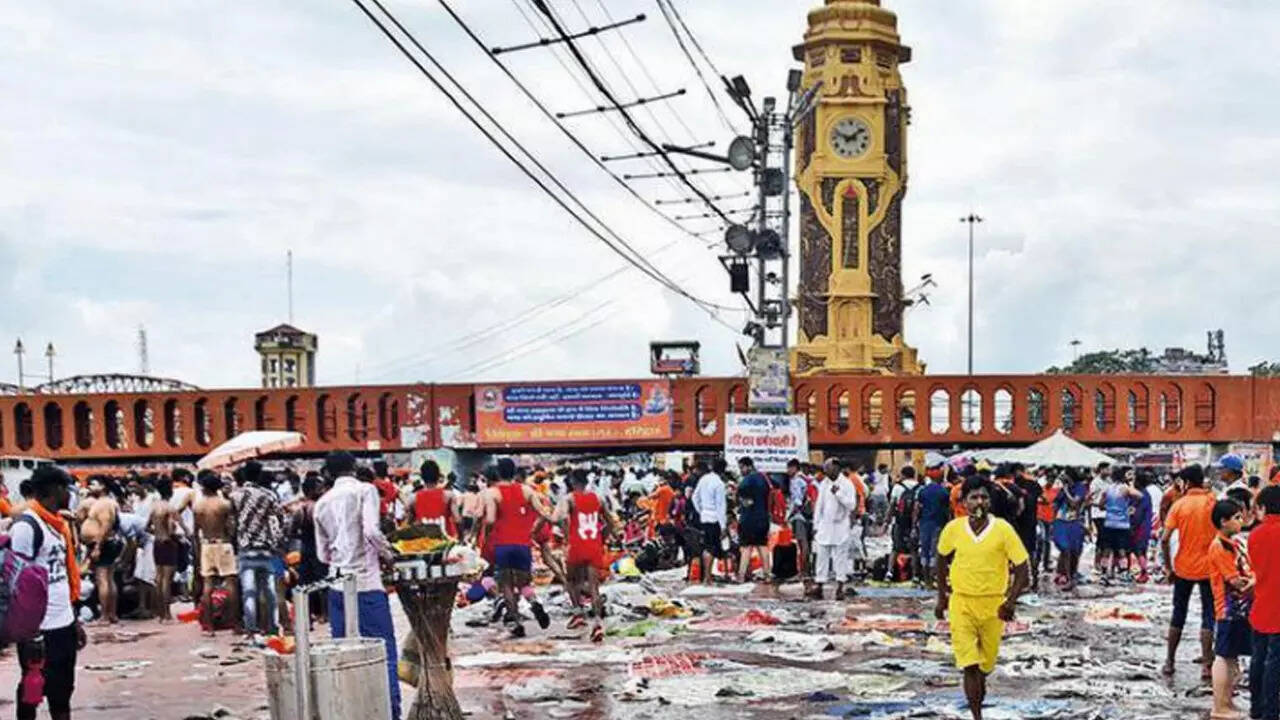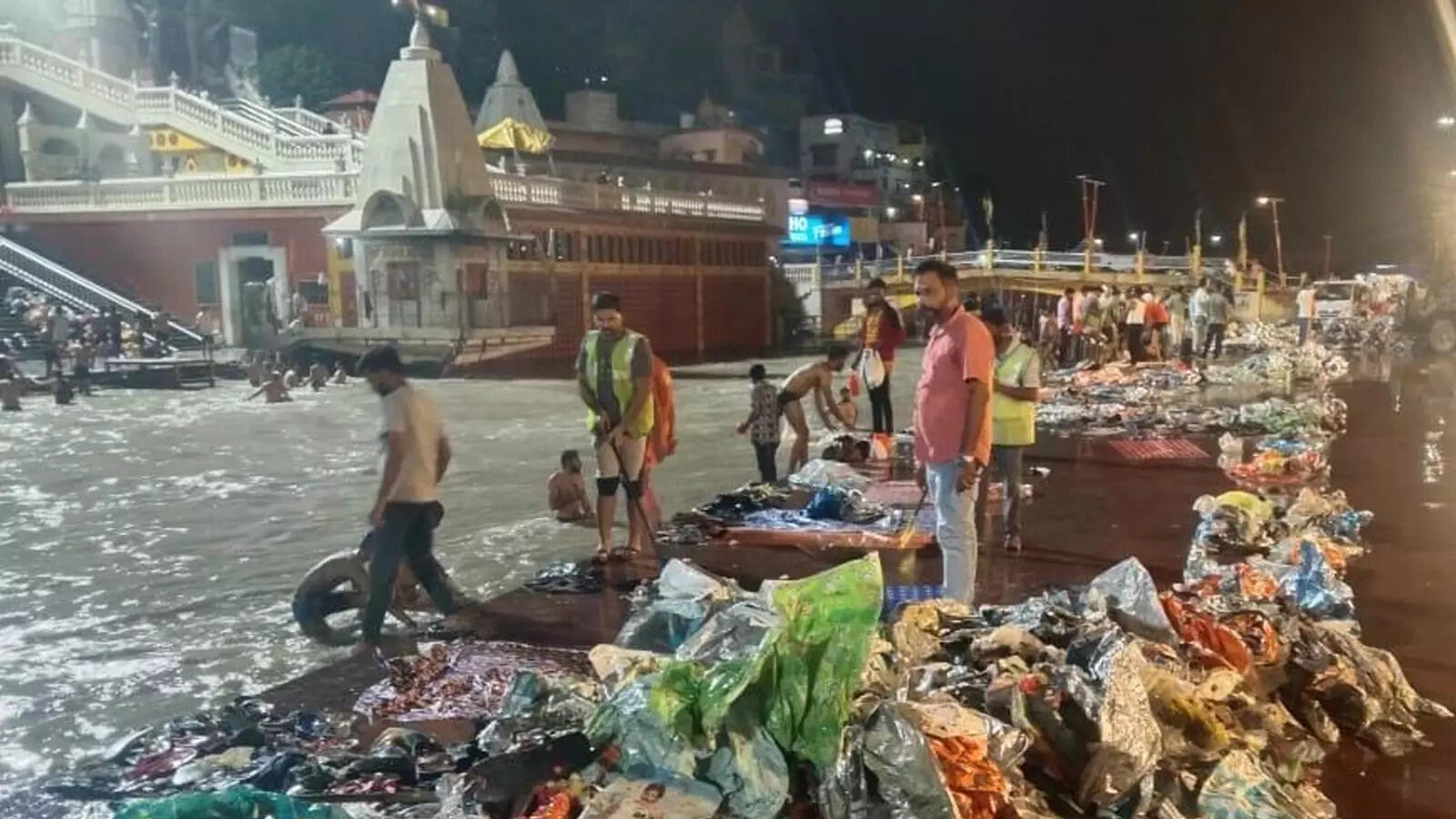
DEHRADUN: The fortnight-long kanwar yatra has left behind approximately 30,000 metric tonnes (MT) of garbage in Haridwar. From shoes and slippers to plastic mattresses and clothes, all kinds of items are scattered around the city, especially around the ghats.

1/7:30,000 MT garbage in Haridwar
<p>For comparison, this is the amount of waste Haridwar would have generated in five months.</p>
2/7:Kanwar yatra leaves behind 30,000 MT garbage in Haridwar
<p>Environmentalists expressed concern about the impact of such large mounds of waste coupled with 'shoddy' processing facilities on the city.<br /></p>
3/7:People brought sound systems worth lakhs to blare here
<p>People brought sound systems worth lakhs to blare here.</p>
4/7:Haridwar waste
<p>The wildlife, especially birds, must have gone through immense stress," said a social activist.</p>
5/7:garbage in haridwar
<p>The administration also deployed 1,100 cleanliness workers to pick up the garbage and take it to the transportation site.</p>
6/7:The year's kanwar yatra did indeed see a huge spike in footfall as it was held after a gap of two years.
<p>The year's kanwar yatra did indeed see a huge spike in footfall as it was held after a gap of two years.</p>
7/7:pilgrimage site in Uttarakhand
<p>Experts said there was an urgent need to set a carrying capacity for each tourism and pilgrimage site in Uttarakhand.</p>Difficult to breathe now: Locals
For comparison, this is the amount of waste Haridwar would have generated in five months.

Environmentalists expressed concern about the impact of such large mounds of waste coupled with "shoddy" processing facilities on the city, which is home to the Ganga river and enveloped by the Rajaji Tiger Reserve on three sides. The reserve houses many IUCN Red list animals and several endangered species of birds and reptiles. "We cannot breathe properly in Haridwar. Open defecation and traffic pollution have completely ruined the air of this town.
People brought sound systems worth lakhs to blare here. The wildlife, especially birds, must have gone through immense stress," said Dr Vijay Verma, a noted social activist.
He has been in Haridwar for over 35 years and has seen many kanwar yatras. This year, he said, was one of the "most damaging" to the ecology of the area. The year's kanwar yatra did indeed see a huge spike in footfall as it was held after a gap of two years. Over 4 crore pilgrims, according to official figures announced by the government, came to Haridwar, as compared to around 1.5 crore in 2019.
Dayanand Saraswati, commissioner of the Haridwar Municipal Corporation, said, "Solid waste remained correspondingly higher than in the previous kanwar yatras because of greater footfall. Many did not respect the sanctity of the holy site and littered carelessly. It was disappointing to see the Shubhash Ghat, Malvidweep, and Kusha Ghat covered with waste. Our teams had to work round the clock."
He added that corporation workers worried about the mountain of garbage all over the banks of the Ganga river and started an intensive cleanliness drive at 10 pm on the last day of the yatra. Open defecation in the banks added to the problem.
Within 48 hours of the onset of the yatra on July 16, the director of Namami Gange, Uday Raj, alerted the administration about flouting of NGT norms, saying human excreta was not being disposed of scientifically. Three "special teams" were formed by the municipal corporation, which remained active during peak "defecating hours" of 5 am to 10 am, to nab culprits, according to documents accessed by TOI.
The administration also deployed 1,100 cleanliness workers to pick up the garbage and take it to the transportation site. Experts said there was an urgent need to set a carrying capacity for each tourism and pilgrimage site in Uttarakhand.
Experts said there was an urgent need to set a carrying capacity for each tourism and pilgrimage site in Uttarakhand. “We will have to seriously think hard about and put a cap on the daily footfall to ensure that natural resources are not overburdened. Garbage accumulation also contaminates the Ganga, threatening aquatic life,” said Ravi Chopra, a noted environmentalist.







